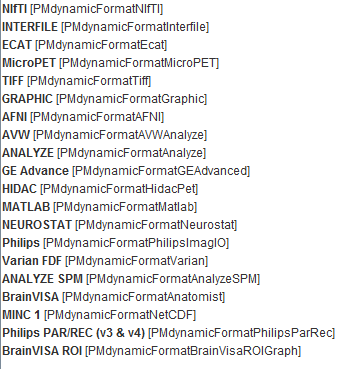Many PMOD functionalities are programmed as plug-ins. Most of these plug-ins are initially installed, but they can be removed or rearranged for each user account with the different tabs. The procedure is always the same and is explained with the plug-ins (the models) of the kinetic modeling tool PKIN.
PKIN Models
When the PKIN models tab is selected, the list of the currently installed model plug-ins is shown. The entries show the name in the model selection of the PKIN tool as bold and in parentheses the file names of the plug-in.
To modify the order how the models appear in the PKIN application please select an entry and move it up/down using the arrows to the right. The ? button shows a quick model explanation.

To remove a model from the list just select its list entry and activate Remove. To add a model back to the list use the Add new button. The appearing dialog window allows selecting one or more plug-in(s) and adding them by the Ok button.

Contents of the different Plug-In Tabs
PXMOD models |
Configuration of the models which appear in the pixel-wise modeling (PXMOD) tool. |
PKIN models |
Configuration of the models which appear in the modeling tool for time-activity curves (PKIN). Tissue contains the actual kinetic models for the tissue TACs, Blood the models for interpolation of the blood activity, Plasma fraction the models for plasma fraction activity and Parent the models for metabolite correction. |
READ/WRITE plug-ins |
Configuration of the image data file formats. Note that only a subset of the formats can be written.
|
LOADING |
Configuration of image processing filters usable during loading. |
Color Tables |
Configuration of user-defined color tables. These files must be ▪located in the resources/colortables sub-directory (see the examples there), ▪text files ending in .cltb, and ▪contain 3 columns with the RGB values (0..255) such as The filename is used as name of the color table. Care must be taken that all color table names are unique, otherwise only one of them will be shown. |
